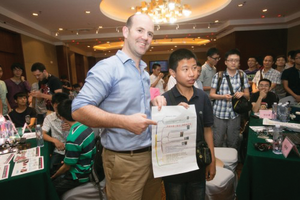New and Improved
We talk with Eben Upton about the new Raspberry Pi Model B+.

We talk with Eben Upton about the new Raspberry Pi Model B+.
The past 12 months have been pretty eventful for the Raspberry Pi Foundation – with a number of new hardware releases (Pi NoIR, Compute Module, Model B+), a new website, a huge push on educational materials and outreach, a number of new employees and even a visit to Buckingham Palace! We talked with Eben Upton about the recent changes and what they mean for the Raspberry Pi.
Raspberry Pi Geek : Has the runaway success of the Raspberry Pi allowed you to expand your charitable and business goals further than you had originally thought possible?
Eben Upton: Yes, I think so. Obviously we are doing much more engineering than we were expecting to do, particularly more software engineering. We have been able to devote a lot more effort to things like the display board and to getting things like the Compute Module to market. The Compute Module was never really even on the agenda early in the Pi's life cycle – that one really is James Adams' brainchild, and it was something that he was very passionate about from day 1, so it is nice to see that go into the market and be really successful. Then, on the charitable side, we have been able to hire more people [and] produce more material, and we are obviously running things like Picademy, the free teacher training program, which has been very popular. We certainly didn't see ourselves getting into teacher training when we started doing this, but it was something that Carrie Anne [Philbin], when she joined us, really wanted to do. Quite a lot of these nice things that we have been able to do are things that people have come into the organization wanting to do. Ben Nuttall, for example, has also developed the GitHub-based documentation and resources section of the new website.
[...]
Pages: 4
Price $15.99
(incl. VAT)